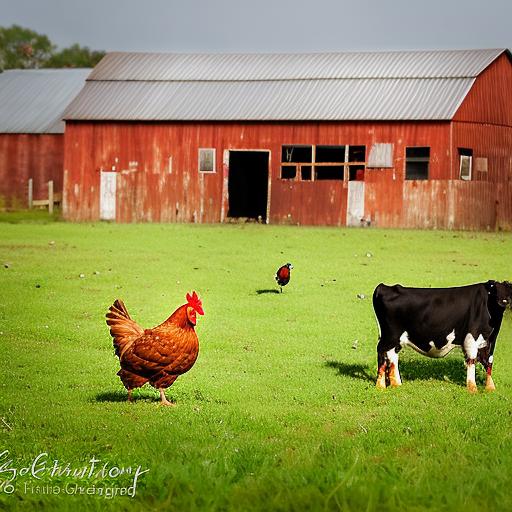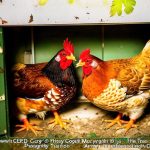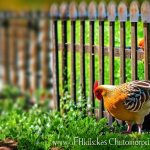Keeping chickens and cows together is a practice that has been gaining popularity among farmers and homesteaders. It involves raising chickens and cows in the same environment, allowing them to interact and benefit from each other’s presence. Personally, I have been keeping chickens and cows together on my farm for several years now, and I have found it to be a highly rewarding and efficient way of farming.
Key Takeaways
- Keeping chickens and cows together can have numerous benefits for small-scale farmers and homesteaders.
- Chickens and cows have different behaviors and social structures that need to be understood to ensure a harmonious environment.
- Adequate housing and feeding requirements must be met for both chickens and cows to thrive in a mixed-species environment.
- Proper management of manure and waste is crucial to prevent health issues and maintain a clean environment.
- Legal considerations, such as zoning laws and animal welfare regulations, should be researched before starting a mixed-species operation.
Benefits of keeping chickens and cows together
One of the main benefits of keeping chickens and cows together is the mutual benefits for both animals. Chickens are known to eat insects, including flies and ticks, which can be harmful to cows. By having chickens roam freely in the cow pasture, they help control the insect population, reducing the need for chemical insecticides. In return, cows provide a source of manure for the chickens, which they can use as fertilizer for their crops.
Another benefit is the increased efficiency in farming. By integrating chickens into the cow pasture, you can make use of the land more effectively. The chickens help to break up the cow manure, spreading it out more evenly across the pasture. This helps to improve soil fertility and reduce the risk of nutrient runoff into nearby water sources. Additionally, the chickens can also help control weeds by scratching and pecking at them.
Keeping chickens and cows together can also result in cost savings. By allowing the chickens to forage for insects and supplement their diet with grass and other vegetation in the cow pasture, you can reduce their feed costs. This can be especially beneficial during the warmer months when insects are abundant and vegetation is plentiful. Additionally, by using chicken manure as fertilizer, you can reduce or eliminate the need for commercial fertilizers, saving money on inputs.
Understanding the behavior of chickens and cows
Chickens and cows have different behaviors that need to be taken into consideration when keeping them together. Chickens are highly social animals that establish a pecking order within their flock. They are also known to be curious and can be easily startled. On the other hand, cows are herd animals that establish a hierarchy within their group. They are generally calm and docile but can become aggressive if they feel threatened.
When chickens and cows are kept together, they will naturally interact with each other. Chickens may peck at the cow’s manure, searching for insects and other tasty treats. Cows, on the other hand, may show curiosity towards the chickens and may even try to investigate them by sniffing or nudging them. It is important to monitor these interactions to ensure that neither animal is being harmed or stressed.
Housing requirements for chickens and cows
Chickens and cows have different housing requirements that need to be met in order to keep them healthy and safe. Chickens require a coop or henhouse where they can roost, lay eggs, and seek shelter from predators and the elements. The coop should be well-ventilated, secure from predators, and provide enough space for the number of chickens being kept.
Cows, on the other hand, require a pasture or barn where they can graze, rest, and seek shelter. The pasture should be securely fenced to prevent cows from wandering off or being attacked by predators. If a barn is used, it should provide enough space for the cows to move around comfortably and have access to fresh water and feed.
When keeping chickens and cows together, it is important to integrate the two types of housing in a way that allows for easy access for both animals. For example, you can place the chicken coop within the cow pasture, allowing the chickens to roam freely during the day while still having access to their coop for laying eggs and roosting at night. This integration helps promote natural behaviors for both animals while ensuring their safety and well-being.
Feeding requirements for chickens and cows
Chickens and cows have different dietary needs that need to be met in order to keep them healthy and productive. Chickens are omnivores and require a balanced diet consisting of grains, protein, fruits, vegetables, and insects. They also require access to fresh water at all times. In a mixed-species environment, chickens can supplement their diet by foraging for insects and vegetation in the cow pasture.
Cows, on the other hand, are herbivores and require a diet consisting mainly of grass and other forage. They have a complex digestive system that allows them to break down cellulose in plant material and extract nutrients from it. Cows also require access to fresh water at all times.
When keeping chickens and cows together, it is important to provide adequate nutrition for both animals. This can be achieved by ensuring that the cow pasture has enough grass and other forage to meet the cows’ dietary needs. Additionally, you can supplement the chickens’ diet with grains, protein-rich feed, fruits, vegetables, and insects to ensure they are getting all the nutrients they need.
Health considerations for chickens and cows

Both chickens and cows are susceptible to certain health issues that need to be monitored and addressed in order to keep them healthy. Chickens are prone to respiratory diseases, parasites, and egg-laying issues. Cows, on the other hand, are susceptible to diseases such as mastitis, lameness, and metabolic disorders.
To prevent and treat illnesses in chickens, it is important to provide a clean and well-ventilated coop, practice good biosecurity measures, and provide a balanced diet. Regular health checks should be conducted to identify any signs of illness or disease early on.
For cows, regular veterinary care is essential to monitor their health and address any issues that may arise. Proper nutrition, clean housing, and regular exercise are also important for maintaining their health and preventing diseases.
Managing manure and waste in a mixed-species environment
Managing manure and waste in a mixed-species environment is an important aspect of keeping chickens and cows together. Both animals produce manure that can be used as fertilizer for crops, reducing the need for commercial fertilizers.
When managing manure from chickens, it is important to regularly clean the coop to prevent the buildup of ammonia and harmful bacteria. The chicken manure can be composted and used as fertilizer for gardens or spread directly on fields.
Cows produce a larger volume of manure compared to chickens. The cow manure can be collected and stored in a designated area, such as a compost pile or manure pit, before being spread on fields as fertilizer. It is important to properly manage the manure to prevent runoff into nearby water sources and to ensure that it is being used in a way that is beneficial for the soil and crops.
Potential challenges and solutions for keeping chickens and cows together
Keeping chickens and cows together can present some challenges that need to be addressed in order to ensure the well-being of both animals. One potential challenge is predators. Chickens are vulnerable to predators such as foxes, raccoons, and hawks, while cows may be targeted by larger predators such as wolves or coyotes.
To protect both animals from predators, it is important to have secure fencing around the pasture and coop. Additionally, providing shelter for the chickens at night can help protect them from nocturnal predators. Using guard animals such as dogs or llamas can also help deter predators from approaching the livestock.
Another potential challenge is aggression between animals. Chickens may peck at each other or at the cows, causing injury or stress. Cows may also become aggressive towards the chickens if they feel threatened or if the chickens are too close to their young.
To prevent aggression between animals, it is important to provide enough space for both chickens and cows to move around comfortably. Providing separate feeding areas for each animal can also help reduce competition and aggression. Monitoring the animals’ behavior and addressing any signs of aggression early on can help prevent injuries and stress.
Legal considerations for keeping chickens and cows together
Before keeping chickens and cows together, it is important to be aware of any zoning laws and regulations that may apply to your area. Some areas may have restrictions on the number of animals you can keep or may require permits or licenses.
It is also important to consider the potential impact of keeping chickens and cows together on neighboring properties. For example, the noise and odor associated with chickens and cows may be a concern for nearby residents. It is important to be a good neighbor and take steps to minimize any potential negative impacts.
Is keeping chickens and cows together right for you?
Keeping chickens and cows together can be a highly rewarding and efficient way of farming, but it is not without its challenges. Before deciding to keep chickens and cows together, it is important to consider factors such as your available space, resources, and level of experience.
If you have the necessary resources and are willing to put in the time and effort to properly care for both animals, keeping chickens and cows together can provide mutual benefits for both animals, increase efficiency in farming, and result in cost savings. However, it is important to do your research, seek advice from experienced farmers, and be prepared to address any challenges that may arise.
In conclusion, keeping chickens and cows together can be a great way to maximize the potential of your farm or homestead. By understanding the behavior of both animals, providing appropriate housing and nutrition, managing manure effectively, addressing potential challenges, and complying with legal requirements, you can create a harmonious environment where both chickens and cows thrive.
If you’re considering keeping chickens and cows together, it’s important to have the right setup to ensure their safety and well-being. One crucial aspect is providing a spacious and secure chicken coop that can accommodate both species comfortably. To get some inspiration for large chicken coop ideas, check out this article from Poultry Wizard. It offers valuable insights and practical tips on creating a suitable environment for your chickens and cows to coexist harmoniously. Whether you’re looking for ideas on coop design or seeking advice on where to place your chicken coop, this article has got you covered. Don’t miss out on this helpful resource: https://poultrywizard.com/keeping-chickens/large-chicken-coop-ideas/.
FAQs
What are the benefits of keeping chickens and cows together?
Keeping chickens and cows together can have several benefits. Chickens can help control pests and insects in the pasture, while cows can provide manure for the chickens to scratch through and eat. Additionally, the two species can have a symbiotic relationship where the chickens help keep the cow’s living area clean by eating insects and parasites.
Is it safe to keep chickens and cows together?
Yes, it is generally safe to keep chickens and cows together. However, it is important to ensure that the chickens have a separate area to roost and lay eggs to prevent them from being trampled by the cows. Additionally, it is important to monitor the cows’ diet to ensure that they are not consuming too much chicken feed or eggs.
What should be considered before keeping chickens and cows together?
Before keeping chickens and cows together, it is important to consider the size of the pasture and the number of animals that will be kept. It is also important to ensure that the animals have access to clean water and adequate shelter. Additionally, it is important to research the dietary needs of both species to ensure that they are receiving proper nutrition.
Can chickens and cows share the same feed?
While chickens and cows can share some of the same feed, it is important to ensure that the feed is appropriate for both species. Chickens require a higher protein diet than cows, so it is important to provide them with a separate source of protein, such as mealworms or soybeans. Additionally, cows should not be fed chicken feed or eggs as it can lead to digestive issues.
What are some potential drawbacks of keeping chickens and cows together?
One potential drawback of keeping chickens and cows together is the risk of disease transmission. Chickens can carry diseases such as avian influenza and salmonella, which can be transmitted to cows. Additionally, cows can carry diseases such as bovine tuberculosis, which can be transmitted to humans. It is important to practice good biosecurity measures to prevent the spread of disease.
Meet Walter, the feathered-friend fanatic of Florida! Nestled in the sunshine state, Walter struts through life with his feathered companions, clucking his way to happiness. With a coop that’s fancier than a five-star hotel, he’s the Don Juan of the chicken world. When he’s not teaching his hens to do the cha-cha, you’ll find him in a heated debate with his prized rooster, Sir Clucks-a-Lot. Walter’s poultry passion is no yolk; he’s the sunny-side-up guy you never knew you needed in your flock of friends!







